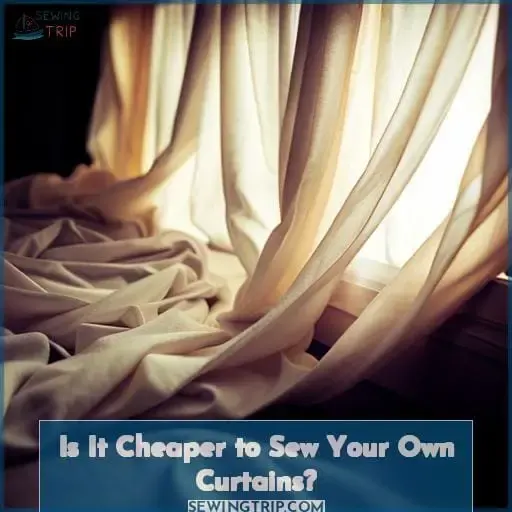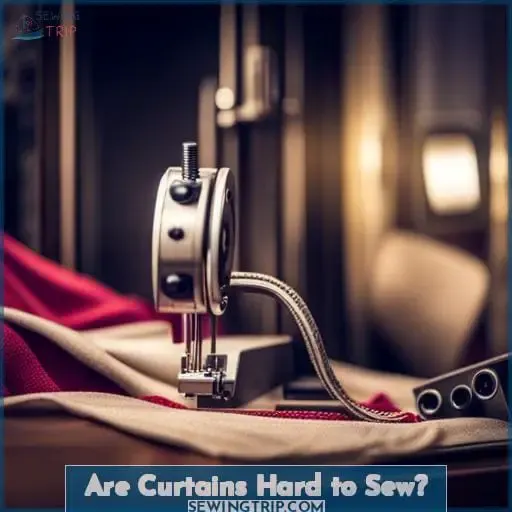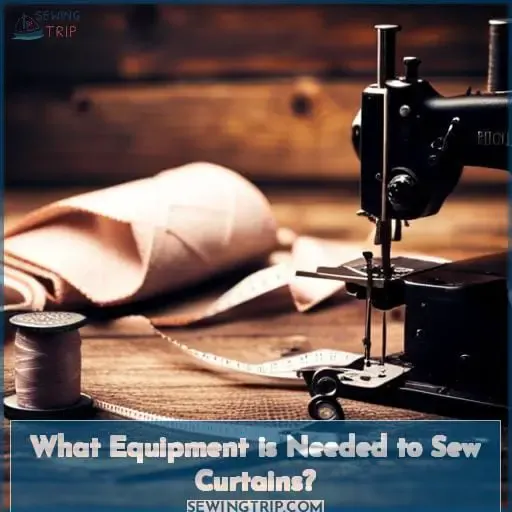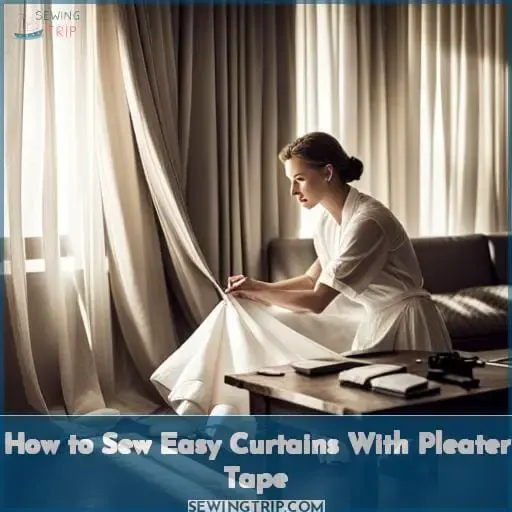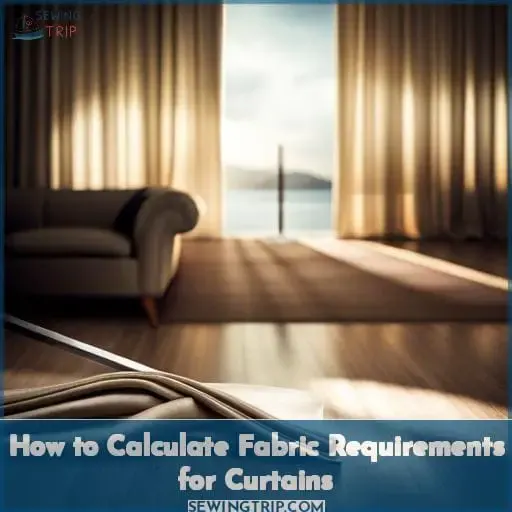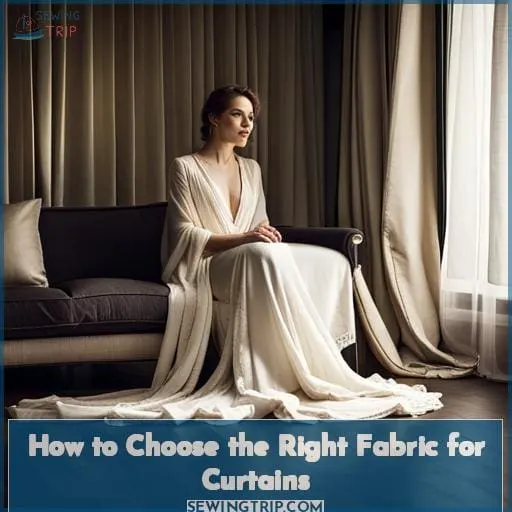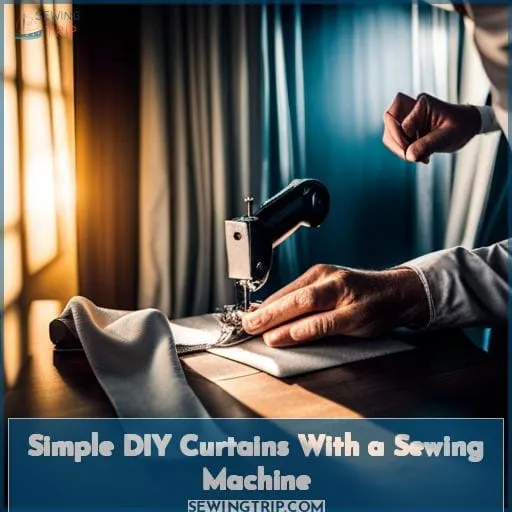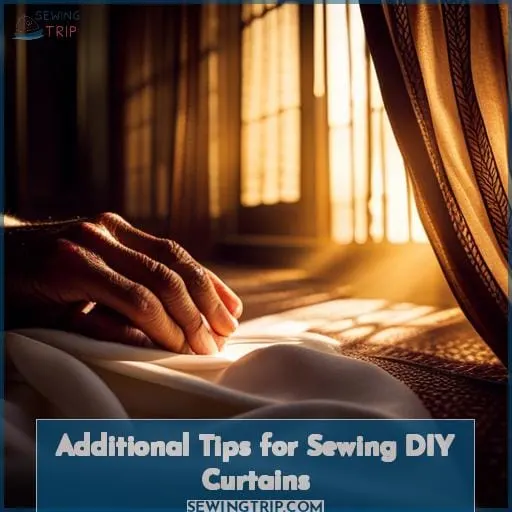This site is supported by our readers. We may earn a commission, at no cost to you, if you purchase through links.
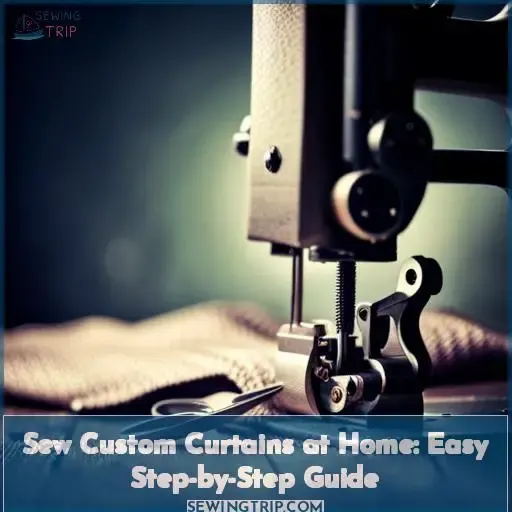 Transform your living space into a chic haven with these DIY curtains that’ll make store-bought drapes seem like a snooze!
Transform your living space into a chic haven with these DIY curtains that’ll make store-bought drapes seem like a snooze!
With just a sewing machine, you’ll embark on a journey where straight seams reign supreme, turning raw fabric into elegant window treatments that’ll make your home the envy of the neighborhood.
Table Of Contents
- Key Takeaways
- Is It Cheaper to Sew Your Own Curtains?
- Are Curtains Hard to Sew?
- What Equipment is Needed to Sew Curtains?
- How to Sew Easy Curtains With Pleater Tape
- What Materials Are Needed to Make DIY Curtains?
- How to Calculate Fabric Requirements for Curtains
- How to Choose the Right Fabric for Curtains
- Simple DIY Curtains With a Sewing Machine
- Sewing Curtains Without a Sewing Machine
- Additional Tips for Sewing DIY Curtains
- Frequently Asked Questions (FAQs)
- Conclusion
Key Takeaways
- Sewing curtains can be a cost-effective and beginner-friendly project, allowing for complete control over fabric, pattern, and style.
- The difficulty of sewing curtains is considered beginner-friendly due to the forgiving nature of drapery fabric and the variety of techniques available.
- Choosing the right fabric is important, considering factors such as drape, weight, light-blocking capabilities, privacy needs, and overall aesthetics.
- Hanging curtains can be done using curtain hooks and a curtain rod, with options for ceiling-mounted hooks, decorative finials, or sleek, hidden curtain tracks.
Is It Cheaper to Sew Your Own Curtains?
You’ll spend less sewing your own curtains compared to purchasing ready-made ones.
The cost of fabric and notions is typically lower than the price of a finished curtain, allowing you to save money.
Moreover, sewing curtains is a skill worth acquiring.
It’s a beginner-friendly project that doesn’t require extensive experience.
With a bit of practice, you’ll be able to create beautiful curtains that perfectly match your taste and décor.
While sewing curtains requires some time and effort, the process is immensely satisfying.
You’ll have complete control over the fabric, pattern, and style of your curtains.
This means you can create unique curtains that reflect your personal style and complement your home décor.
Additionally, you can customize the curtains to fit your windows perfectly, ensuring a polished and professional look.
Are Curtains Hard to Sew?
Alright, let’s dive into the question of whether sewing curtains is a daunting task.
Curtains, often considered the crowning glory of window treatments, may seem intimidating to sew, but they’re actually quite beginner-friendly.
The straightforward construction, coupled with the forgiving nature of drapery fabric, makes them an ideal project for those new to the world of sewing.
The beauty of sewing curtains lies in the plethora of techniques you can employ.
Whether you prefer the precision of a sewing machine or the calming rhythm of hand-stitching, both methods yield satisfying results.
Plus, with a sewing machine, you’ll have the added advantage of speed and consistent seam allowances.
The customization options are endless.
From vibrant solids to elegant patterns, the fabric selection is a treasure trove of choices.
You can mix and match colors, experiment with textures, and create unique patterns that reflect your personal style.
Unleash your creativity and let your curtains become a reflection of your individuality.
So, are curtains hard to sew? Absolutely not!
With a bit of patience, attention to detail, and a dash of creativity, you’ll be swathed in the beauty of custom-made curtains in no time.
What Equipment is Needed to Sew Curtains?
Your sewing arsenal should include:
- Sewing machine
- Measuring tape
- Scissors
- Iron
These fundamental tools will equip you to tackle basic curtain projects.
However, if you’re a beginner seeking a less daunting approach, consider no-sew methods:
- Heat ‘n Bond tape
- Curtain clips
These can be your secret weapons for creating curtains without a sewing machine.
Beyond the basics, curtain-making tools can elevate your projects:
- Hard ruler and square for precise measurements
- Pleater tape and curtain hooks for pleated curtains
These specialized tools can transform your curtains from simple drapes to elegant window treatments.
Choosing the right curtain rod is crucial for a polished look:
- Tension rods
- Cafe rods
- Traverse rods
Decide based on your window type and desired style.
Fabric selection is another key aspect of successful curtain-making:
- Opt for fabrics with good drape and weight, such as cotton, linen, or velvet
- Consider factors like light-blocking capabilities, privacy needs, and overall aesthetics
With the right tools and materials, sewing curtains becomes a fulfilling and creative endeavor. Transform your windows into stylish focal points while adding a personal touch to your home décor.
How to Sew Easy Curtains With Pleater Tape
With pleater tape, sew curtains quickly and easily.
Choose from various pleater tape options, including pinch pleat, box pleat, and goblet pleat, to achieve different hanging methods and curtain fabric patterns.
Experiment with window treatment styles, such as tailored pleats for a clean look or cascading folds for a romantic touch.
Vary the pleat depth to control the fullness of your curtains, creating elegant drapes or airy sheers.
-
Measure and Cut:
- Determine the desired curtain length and add 7 inches for hems and pleater tape.
- Measure and cut the curtain fabric to the desired width, accounting for pleats.
-
Sew Pleater Tape:
- Fold the top edge of the curtain fabric 1 inch to the wrong side and press.
- Fold again 2 inches to the wrong side and press.
- Stitch along the folded edge to create a casing for the pleater tape.
- Insert the pleater tape into the casing and pin in place.
- Stitch along the top edge of the pleater tape to secure.
-
Sew Side Hems:
- Fold and press the side edges of the curtain fabric 1 inch to the wrong side.
- Fold again 1 inch to the wrong side and press.
- Stitch along the folded edges to create hems.
-
Hang Curtains:
- Attach curtain hooks to the pleater tape and hang the curtains on the curtain rod.
- Adjust the pleats to achieve the desired fullness.
What Materials Are Needed to Make DIY Curtains?
To create your own curtains, you’ll need:
- Drapery fabric
- Pleater tape
- Curtain rings with hooks
- Curtain hooks for pleater tape
- Basic sewing supplies
Consider:
- Pleated or non-pleated curtains
- Sheer or blackout curtains
- Fabric patterns and colors that complement your home décor
Decide:
- Sew by machine or hand
- If using a machine, ensure you have polyester thread and medium or heavyweight interfacing
- If hand-sewn, Heat ‘n Bond tape is a great option
Gather:
- Measuring tools like a hard ruler or square, a measuring tape, and fabric scissors
- Stick pins to hold the fabric in place
- Iron and ironing board to press the seams and remove wrinkles
Calculate:
- Measure from the curtain rod to the desired curtain length, and add 7 inches for hems and space between hooks and the top of the drape
- Multiply the window width by two to account for pleating
- If necessary, sew two fabric pieces together to achieve the desired width
How to Calculate Fabric Requirements for Curtains
Now that you’ve gathered your materials, let’s tackle the task of calculating the precise amount of fabric you’ll need for your custom curtains. It’s a simple process that ensures you have just enough fabric, without any leftover scraps.
-
Measure the Desired Curtain Length:
- Determine how long you want your curtains to be. Will they gracefully graze the floor or end just below the window sill?
- Measure from the top of the curtain rod to your desired length, making sure to include seam allowances.
-
Calculate Fabric Quantity:
- Multiply the curtain length by two. This accounts for the fabric needed for both panels of your curtains.
-
Measure Window Width:
- Measure the width of your window, from one end to the other.
- Multiply this measurement by two to account for pleating and gathering.
-
Add Seam Allowances:
- Don’t forget to add seam allowances to your fabric calculations. Typically, you’ll need an extra 1-2 inches on each side for seams.
With these measurements in hand, you can confidently purchase the necessary amount of fabric. Choose a fabric that complements your décor, keeping in mind its weight, draping qualities, and ease of care.
Next, let’s dive into the exciting process of sewing your curtains. We’ll guide you through each step, from pinning and sewing the fabric to creating a lining hem and adding finishing touches.
How to Choose the Right Fabric for Curtains
Selecting the right fabric is key to creating stunning curtains.
Consider factors like weight, draping qualities, durability, and ease of care.
Explore décor fabric options online or at local fabric stores to find the perfect fabric that complements your home décor.
Fabric Considerations
Your fabric choice impacts your curtains’ appearance and functionality.
Prioritize durability and easy maintenance.
Consider the fabric’s color, style, and pattern to match your décor.
Cotton-linen blends offer breathability and durability.
Explore décor fabric options online or at local stores for unique patterns and textures.
Floral fabrics add a touch of elegance, while solid colors provide a minimalist look.
Choose wisely, as your fabric sets the tone for your curtains’ overall appeal.
Cost and Customization
When selecting fabric, consider:
- Quality
- Style
- Color
- Patterns
Opt for durable materials that complement your décor.
Match colors and patterns to existing elements in your room.
Consider your budget and curtain measurements, ensuring you have enough fabric for the desired fullness.
Explore various:
- Curtain patterns
- Lining options
- Hooks
- Pleater tape
To customize your curtains further.
Selecting Drapery Fabric
With cost savings and customization in mind, let’s dive into selecting the perfect drapery fabric for your DIY curtains.
Consider:
- Pattern selection
- Color coordination
- Fabric weight
- Texture choice
To match your room’s style and décor.
Lining options add privacy, insulation, and fullness to your curtains.
Choose curtain fabric that complements your furniture, artwork, and flooring.
Explore décor fabric options online or at local stores, keeping in mind:
- Durability
- Ease of care
- Your desired drape
Simple DIY Curtains With a Sewing Machine
Begin by measuring your windows and selecting fabric for your curtains.
Consider the room’s décor, the amount of light you want to let in, and the fabric’s weight and texture.
You can opt for a solid color or a fun pattern that reflects your personal style.
With your fabric in hand, it’s time to start sewing.
If you’re a beginner, choose a beginner-friendly fabric like cotton or linen.
These fabrics are easy to sew and come in a wide range of colors and patterns.
You can also opt for a fabric with a lining, which will help to block out light and add fullness to your curtains.
First, cut your fabric to the desired size.
Then, sew the top and bottom hems.
To create a rod pocket for hanging your curtains, fold the top hem down twice and stitch it in place.
For the bottom hem, simply fold it up once and stitch it in place.
Next, it’s time to attach the pleater tape.
Pleater tape is a type of fabric tape that helps to create evenly spaced pleats in your curtains.
Pin the pleater tape to the back of your curtain panel, aligning the top edge of the tape with the top edge of the curtain.
Stitch the pleater tape in place using a straight stitch.
Once the pleater tape is attached, you can hang your curtains.
Simply slide the curtain rod through the rod pocket at the top of the curtain panel.
Alternatively, you can use curtain clips or hooks to hang your curtains.
Sewing Curtains Without a Sewing Machine
Alright, let’s tackle sewing curtains without a sewing machine – a great option for beginners or those without this tool. We’ll explore various methods to bond fabric without stitching, giving you a seamless finish.
First up, let’s look at no-sew curtain alternatives:
- Iron-on curtain tape: Create hems and pleats with just an iron.
- Fabric glue for curtains: Provides a strong hold without sewing.
- Curtain grommet installation: Insert grommets into the fabric and hang curtains with clips or rings.
Now, let’s dive into bonding curtain fabric:
- Heat ‘n Bond tape: Double-sided fusible tape that joins fabric when heated with an iron.
- Curtain interfacing: Cut to the desired size, place between curtain fabric and lining, and iron on. Provides extra body and structure.
Don’t forget about side hems:
- Fabric glue or iron-on hem tape: Fold fabric to the desired hem width, apply adhesive, and press or iron in place.
With these no-sew techniques, you can create beautiful curtains that add a personal touch to your home without the need for a sewing machine.
Additional Tips for Sewing DIY Curtains
-
Choose high-quality curtain fabric that complements your home décor.
Consider factors like fabric weight, draping qualities, and opacity to achieve the desired look and functionality.
-
Experiment with curtain colors and patterns.
Mix and match fabrics to create a unique and personalized look that reflects your style.
-
Match curtains to your room’s design.
Consider the overall design of your room when selecting curtain fabric.
Choose curtains that harmonize with the color scheme, furniture, and other décor elements to create a cohesive and inviting space.
-
Add personal touches with curtain decorations.
Personalize your curtains with decorative elements such as trims, fringes, or tassels.
You can also add blackout lining for privacy or thermal insulation, or use a contrasting fabric for the lining to add a pop of color.
Frequently Asked Questions (FAQs)
Can I use any type of fabric to make curtains?
Unleash your creativity and select fabrics that resonate with your unique style.
Heavy cotton or cotton-linen blends offer durability and timeless appeal.
Explore decor fabric options online or at local stores to unveil a world of colors, patterns, and textures to match your vision.
How do I determine the right size of fabric for my curtains?
To determine the perfect fabric size for your curtains:
- Measure from the desired curtain rod placement to the preferred length, considering an extra 7 inches for hems and hook space.
- Double the window width to account for pleating.
- Consider sewing multiple fabric pieces together if needed.
What are the best ways to hang curtains?
For elegant drapery, hang curtains from ceiling-mounted hooks.
For a classic look, use curtain rods with decorative finials.
For a modern touch, opt for sleek, hidden curtain tracks.
How do I care for my curtains?
Protect your precious curtains with tender care.
Embrace gentle laundering cycles, avoiding harsh detergents and excessive heat.
Let them bask in the sun’s embrace, refreshing their beauty.
Or entrust them to a trusted dry cleaner for expert care.
Where can I find inspiration for unique curtain designs?
Discover unique curtain designs that reflect your style and taste.
Explore home décor magazines, online galleries, and social media platforms for inspiring ideas.
Embrace your creativity and let your imagination soar as you envision curtains that transform your windows into works of art.
Conclusion
As you embark on this creative journey, envision yourself as a sculptor, transforming raw fabric into an expression of your unique style.
With each stitch, you’ll breathe life into your curtains, imbuing them with a story that’s uniquely yours.
The result will be a symphony of colors and textures, a masterpiece that’ll transform your windows into portals of inspiration.
So, pick up your needle and thread, and let the rhythm of your sewing machine guide you as you create curtains that are as unique and captivating as you are.

